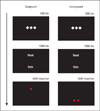Attention to threats and combat-related posttraumatic stress symptoms: prospective associations and moderation by the serotonin transporter gene
- PMID: 23407816
- PMCID: PMC4469781
- DOI: 10.1001/2013.jamapsychiatry.188
Attention to threats and combat-related posttraumatic stress symptoms: prospective associations and moderation by the serotonin transporter gene
Abstract
Importance: Combat places soldiers at risk for posttraumatic stress disorder (PTSD). The excessive rates of PTSD and other adjustment disorders in soldiers returning home make it imperative to identify risk and resilience factors that could be targeted by novel therapeutic treatments.
Objective: To investigate the interplay among attention to threat, combat exposure, and other risk factors for PTSD symptoms in soldiers deployed to combat.
Design and setting: Longitudinal prospective study of Israeli Defense Force infantry soldiers carried out in 2008 through 2010. Repeated measurements during a 1-year period included baseline and predeployment data collected in training camps and deployment data collected in the combat theater.
Participants: Infantry soldiers (1085 men; mean age, 18.8 years).
Main outcome measures: Postcombat PTSD symptoms. RESULTS Soldiers developed threat vigilance during combat deployment, particularly when they were exposed to high-intensity combat, as indicated by faster response times to targets appearing at the location of threat relative to neutral stimuli (P < .001). Threat-related attention bias also interacted with combat exposure to predict risk for PTSD (P < .05). Bias toward threat at recruitment (P < .001) and bias away from threat just before deployment (P < .05) predicted postcombat PTSD symptoms. Moreover, these threat-related attention associations with PTSD were moderated by genetic and environmental factors, including serotonin transporter (5-HTTLPR) genotype.
Conclusions and relevance: Combat exposure interacts with threat-related attention to place soldiers at risk for PTSD, and interactions with other risk factors account for considerable variance in PTSD vulnerability. Understanding these associations informs research on novel attention bias modification techniques and prevention of PTSD.
Conflict of interest statement
Figures



Similar articles
-
Association of time since deployment, combat intensity, and posttraumatic stress symptoms with neuropsychological outcomes following Iraq war deployment.Arch Gen Psychiatry. 2009 Sep;66(9):996-1004. doi: 10.1001/archgenpsychiatry.2009.109. Arch Gen Psychiatry. 2009. PMID: 19736356
-
Postdeployment threat-related attention bias interacts with combat exposure to account for PTSD and anxiety symptoms in soldiers.Depress Anxiety. 2014 Feb;31(2):124-9. doi: 10.1002/da.22157. Epub 2013 Aug 19. Depress Anxiety. 2014. PMID: 23959788
-
Emotional reactivity to a single inhalation of 35% carbon dioxide and its association with later symptoms of posttraumatic stress disorder and anxiety in soldiers deployed to Iraq.Arch Gen Psychiatry. 2012 Nov;69(11):1161-8. doi: 10.1001/archgenpsychiatry.2012.8. Arch Gen Psychiatry. 2012. PMID: 23117637
-
[Posttraumatic stress disorder (PTSD) as a consequence of the interaction between an individual genetic susceptibility, a traumatogenic event and a social context].Encephale. 2012 Oct;38(5):373-80. doi: 10.1016/j.encep.2011.12.003. Epub 2012 Jan 24. Encephale. 2012. PMID: 23062450 Review. French.
-
Vulnerability to lasting anxiogenic effects of brief exposure to predator stimuli: sex, serotonin and other factors-relevance to PTSD.Neurosci Biobehav Rev. 2008 Sep;32(7):1287-92. doi: 10.1016/j.neubiorev.2008.05.005. Epub 2008 May 13. Neurosci Biobehav Rev. 2008. PMID: 18550167 Free PMC article. Review.
Cited by
-
Attention bias variability and symptoms of posttraumatic stress disorder.J Trauma Stress. 2014 Apr;27(2):232-239. doi: 10.1002/jts.21899. Epub 2014 Mar 6. J Trauma Stress. 2014. PMID: 24604631 Free PMC article.
-
Differential sensitivity to the environment: contribution of cognitive biases and genes to psychological wellbeing.Mol Psychiatry. 2016 Dec;21(12):1657-1662. doi: 10.1038/mp.2016.114. Epub 2016 Jul 19. Mol Psychiatry. 2016. PMID: 27431291 Free PMC article.
-
Frequency of Improvised Explosive Devices and Suicide Attempts in the U.S. Army.Mil Med. 2017 Mar;182(3):e1697-e1703. doi: 10.7205/MILMED-D-16-00270. Mil Med. 2017. PMID: 28290945 Free PMC article.
-
Attention allocation in posttraumatic stress disorder: an eye-tracking study.Psychol Med. 2021 Feb 26:1-10. doi: 10.1017/S0033291721000581. Online ahead of print. Psychol Med. 2021. PMID: 33634768 Free PMC article.
-
Choosing certainty over risk: Associations of PTSD symptom severity with memory sampling during experiential decision making.J Anxiety Disord. 2025 Mar;110:102979. doi: 10.1016/j.janxdis.2025.102979. Epub 2025 Jan 26. J Anxiety Disord. 2025. PMID: 39889322
References
-
- McNally RJ. Progress and controversy in the study of posttraumatic stress disorder. Annu Rev Psychol. 2003;54:229–252. - PubMed
-
- Yehuda R, LeDoux J. Response variation following trauma: a translational neuroscience approach to understanding PTSD. Neuron. 2007;56(1):19–32. - PubMed
-
- Bar-Haim Y, Lamy D, Pergamin L, Bakermans-Kranenburg MJ, van IJzendoorn MH. Threat-related attentional bias in anxious and nonanxious individuals: a meta-analytic study. Psychol Bull. 2007;133(1):1–24. - PubMed
-
- MacLeod C, Mathews A, Tata P. Attentional bias in emotional disorders. J Ab-norm Psychol. 1986;95(1):15–20. - PubMed
-
- Wald I, Lubin G, Holoshitz Y, Muller D, Fruchter E, Pine DS, Charney DS, Bar-Haim Y. Battlefield-like stress following simulated combat and suppression of attention bias to threat. Psychol Med. 2011;41(4):699–707. - PubMed
Publication types
MeSH terms
Substances
Grants and funding
LinkOut - more resources
Full Text Sources
Other Literature Sources
Medical
Molecular Biology Databases

